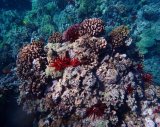EPA Research in Hawai'i
EPA researchers are working hard to protect communities across the nation. Learn about some of the work EPA researchers are doing in Hawai'i.
- Helping Community Drinking Water Systems Find Cost-Effective Solutions to Treatment Challenges
- Evaluating Hawaiian Stony Corals
- Coral and Climate Adaptation Planning
- Protecting Coral with Innovative Watershed Management Research in West Maui
- Guide to Coral Reef Restoration Planning and Design
- EPA Educational Tool Inspires MIT Team to Develop DIY Air Sensor Kit for Hawai'i Educators
For more EPA work, see EPA in Hawai'i.
Helping Community Drinking Water Systems Find Cost-Effective Solutions to Treatment Challenges
Emerging contaminants, such as per- and polyfluoroalkyl substances (PFAS), are challenging to drinking water systems across the country. Effective treatment for emerging contaminants can be unknown, difficult, and extremely costly. Working with the state of Hawai'i, EPA researchers are providing technical assistance to a small community water system with PFAS concerns to help them identify optimal, cost-effective treatment methods and optimize the long-term operation of their chosen technology. These efforts will also be used to develop best practices and performance and cost estimate tools so water utilities across the country can make informed treatment and operational choices.
Evaluating Hawaiian Stony Corals
EPA's Office of Research and Development (ORD), in collaboration with EPA Region 9, has taken steps to include investigations of Hawai'i corals in their research. As of 2023, ORD now houses Hawaiian coral at the Gulf Ecosystem Measurement and Modeling Division's Coral Research Facility. Researchers there will expose Hawaiian corals to the flocculant chitosan to assess its impacts on growth. The results of the research will determine if the use of flocculant can be used in West Maui’s watershed to be used as a management tool to reduce sediment exposure to West Maui’s coral reefs. Read the journal article about the results of this work: Chitosan has the potential to improve water quality without negative effects on the coral.
Coral and Climate Adaptation Planning
ORD worked with the West Maui Ridge to Reef (R2R) Initiative, founded by Hawaii Department of Land and Natural Resources, on climate-smart management planning through a cooperative effort of the Climate Change Working Group of the Interagency U.S. Coral Reef Task Force led by EPA. The Task Force and R2R teams collaborated through workshops, webinars, and expert consultations to develop the Adaptation Design Tool and Manager’s Guide to Coral Reef Restoration Planning and Design.
Protecting Coral with Innovative Watershed Management Research in West Maui

West Maui is a mountainous region in Hawai'i impacted by former agricultural plantations. When sediment-laden rainwater runs down the mountains and is washed into surrounding water retention ponds and then out onto reefs, it can cloud the water and interfere with the ability of coral to feed, grow, and reproduce. EPA scientists are collaborating with the West Maui Ridge to Reef Initiative to explore ways help control fine sediment runoff which threatens the health of coral reefs. Read Keeping West Maui’s Coral Floral: EPA Scientists Pilot Innovative Watershed Management Research.
Guide to Coral Reef Restoration Planning and Design

Coral reefs are among the most vital and diverse habitats in the world. However, climate change and human actions are severely threatening these magnificent ecosystems. EPA recently joined NOAA and the Nature Conservancy to release a guide for reef managers as they plan, design, and implement restoration projects. The guide has been used to assist reef managers in developing draft Restoration Action Plans for the U.S. jurisdictions of American Samoa, the Commonwealth of the Northern Mariana Islands, Guam, and Hawaii. NOAA also uses the Guide to support restoration planning in the U.S. Virgin Islands and Puerto Rico. Read EPA Joins the Nature Conservancy, NOAA, in Releasing Guide to Coral Reef Restoration Planning and Design.
EPA Educational Tool Inspires MIT Team to Develop DIY Air Sensor Kit for Hawai’i Educators
Educators at Massachusetts Institute of Technology (MIT) created a new version of a particle meter to help teachers in Hawai'i teach students about air quality and engineering. The sensor kit and its assembly instructions grew out of a larger, EPA-funded STAR grant project led by MIT and local community partner The Kohala Center, an independent community-based research center on Hawai'i’s Big Island, to monitor harmful pollutants emitting from Hawai'i’s Kīlauea volcano. Read EPA Educational Tool Inspires MIT Team to Develop DIY Air Sensor Kit for Hawai’i Educators.
